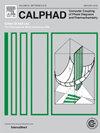Experimental investigation and thermodynamic optimization of the Ni–Ta–Ti system
IF 1.9
3区 材料科学
Q4 CHEMISTRY, PHYSICAL
Calphad-computer Coupling of Phase Diagrams and Thermochemistry
Pub Date : 2025-01-29
DOI:10.1016/j.calphad.2025.102803
引用次数: 0
Abstract
The liquidus surface projection of the Ni–Ta–Ti system was constructed in this work. Thirty-seven as-cast alloys were characterized using scanning electron microscope equipped with energy dispersive spectrometer (SEM/EDS) and X-ray diffraction (XRD) methods to analyze the primary phases and solidification paths of alloys. Ten primary solidification regions of bcc(Ta,Ti), fcc(Ni), NiTi, NiTi2, NiTa2, Ni2Ta, Ni3Ta, Ni3Ti, μ and τ were determined. The crystal structure of the intermetallic phase τ was identified as the Ni3Sn type with space group P63/mmc. Moreover, the thermodynamic parameters of the Ni–Ta–Ti system were optimized via the CALculation of PHAse Diagram (CALPHAD) method based on the available experimental data. In this work, NiTi2, Ni3Ti, NiTa2, Ni2Ta, Ni3Ta and τ were modelled by two-sublattice model (Ni,Ta,Ti)m(Ni,Ta,Ti)n. A four-sublattice model (Ni,Ta,Ti)1(Ta,Ti)4(Ni,Ta,Ti)2(Ni,Ta,Ti)6 was adopted to describe μ. The calculated liquidus surface projection and isothermal sections with the obtained thermodynamic parameters were consistent with the experimental data.
Ni-Ta-Ti体系的实验研究与热力学优化
本文建立了Ni-Ta-Ti体系的液面投影。采用扫描电镜、能谱仪(SEM/EDS)和x射线衍射仪(XRD)对37种铸态合金进行了表征,分析了合金的初相和凝固路径。确定了bcc(Ta,Ti)、fcc(Ni)、NiTi、NiTi2、NiTa2、Ni2Ta、Ni3Ta、Ni3Ti、μ和τ等10个初始凝固区域。金属间相τ的晶体结构为Ni3Sn型,空间群为P63/mmc。基于已有的实验数据,采用相图计算(CALPHAD)方法对Ni-Ta-Ti体系的热力学参数进行了优化。本文采用双亚晶格模型(Ni,Ta,Ti)m(Ni,Ta,Ti)n对NiTi2, Ni3Ti, NiTa2, Ni2Ta, Ni3Ta和τ进行建模。采用四亚晶格模型(Ni,Ta,Ti)1(Ta,Ti)4(Ni,Ta,Ti)2(Ni,Ta,Ti)6来描述μ。计算得到的液面投影和等温剖面与实验数据吻合较好。
本文章由计算机程序翻译,如有差异,请以英文原文为准。
求助全文
约1分钟内获得全文
求助全文
来源期刊
CiteScore
4.00
自引率
16.70%
发文量
94
审稿时长
2.5 months
期刊介绍:
The design of industrial processes requires reliable thermodynamic data. CALPHAD (Computer Coupling of Phase Diagrams and Thermochemistry) aims to promote computational thermodynamics through development of models to represent thermodynamic properties for various phases which permit prediction of properties of multicomponent systems from those of binary and ternary subsystems, critical assessment of data and their incorporation into self-consistent databases, development of software to optimize and derive thermodynamic parameters and the development and use of databanks for calculations to improve understanding of various industrial and technological processes. This work is disseminated through the CALPHAD journal and its annual conference.

 求助内容:
求助内容: 应助结果提醒方式:
应助结果提醒方式:


